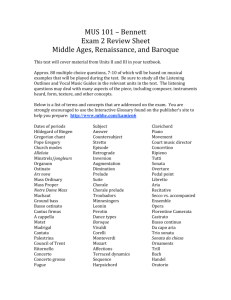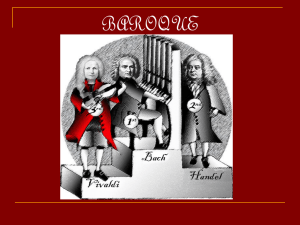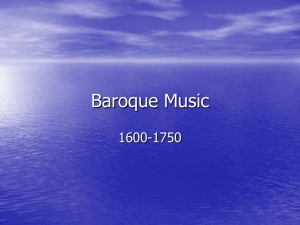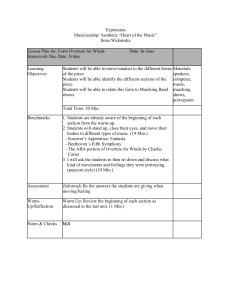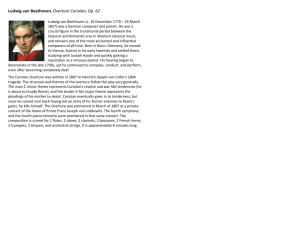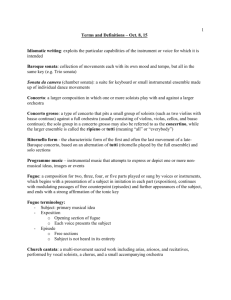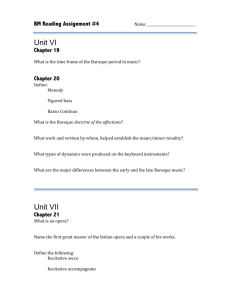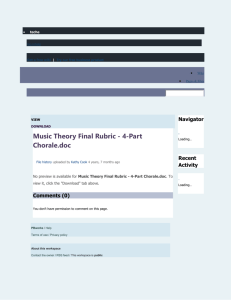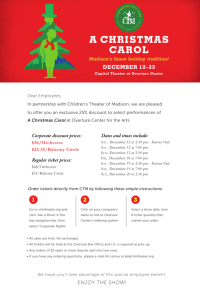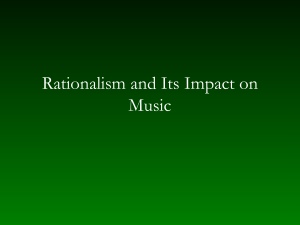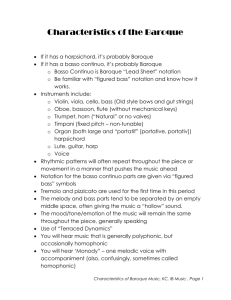Higher Listening
advertisement
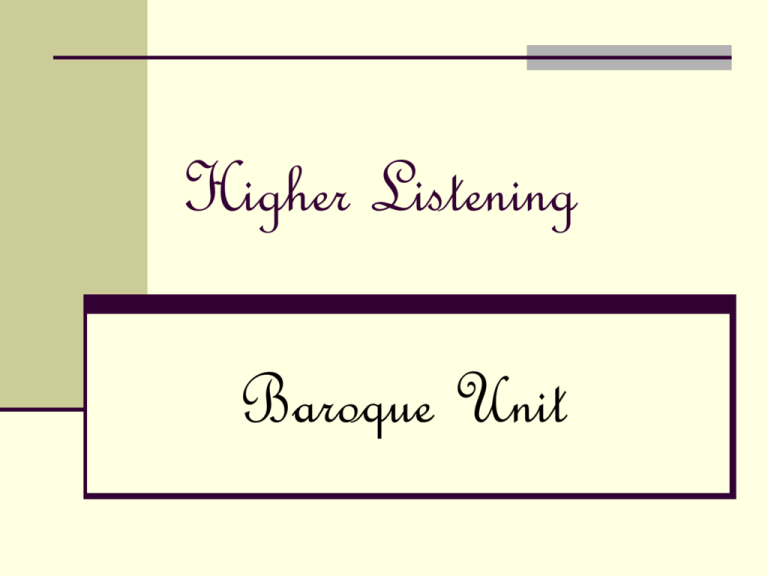
Higher Listening Baroque Unit Standard Grade Concepts to remember: Oratorio Opera Recitative Aria Homophonic Polyphonic Melisma Syllabic Antiphonal Cantata Passion Chorale Tierce de Picardie Overture Cadences Ornaments Obbligato Chorale Prelude Higher Baroque Concepts Augmentation Basso Continuo Chaconne/Passacaglia Concertino Concerto Grosso Da Capo Aria Diminution French/Italian Overture Fugue Ornaments Real Answer Ripieno Ritornello Suite Tonal Answer Chords Developments in Baroque Period More contrast in texture – Homophonic/Polyphonic New styles – concerto grosso, chorale prelude, suite Basso Continuo Range of ornaments used Basso Continuo Vocal music was developed by adding a Basso Continuo. This is an accompaniment which consists of a bass- line and a harmonic chordal part. The bass-line was usually played by Cello. The harmony part was played by a Keyboard instrument – usually Harpsichord or Organ YouTube - Cavalli - il Giasone "Delizie Contente" Michael Chance The Overture An Overture is the instrumental piece of music preceding an Opera or Oratorio. There are two types of Overture: French and Italian. French – Slow, crisp dotted rhythms – faster section Italian – Fast – Slow –Fast YouTube - Hasse: Overture "Artaserse" (Italian Overture) Da Capo Aria Found in both Opera and Oratorio It is basically an Aria in Ternary Form. The A section is not written out again but the player is instructed to go back to the beginning – Da Capo. The Concerto Grosso This preceded the Symphony. Don’t confuse with the Concerto! This consists of Two groups of instruments: The Ripieno – main group The Concertino – soloist group During the concerto grosso, there is often a recurring theme – the Ritornello The Suite This is a group of pieces played by more than one instrument. Chaconne/Passacaglia – Dances in triple time. Based on a ground bass Other dances include: Sarabande - Slow, Triple time Gigue – fast, Compound time Courante – Moderate, triple time Allemande – Quadruple time, moderate Bouree – Duple metre, lively Minuet – triple time, moderate Chorale Prelude The Chorale is a vocal work based on a hymn tune, mainly homophonic texture. The prelude is the instrumental introduction. The chorale prelude is usually played on the Organ. YouTube - Brahms Chorale Prelude "Es ist ein Ros' entsprungen" Opus122#8 The Fugue A complex version of a Canon/Round. Contrapuntal texture and based on Imitation Consists of 3 or 4 parts First Section Episode Final section Middle section Episode First Section of Fugue Main theme – SUBJECT is first heard Often a counter melody or COUNTER SUBJECT is heard at the same time Analysis of Bach's g minor fugue BWV 861 by Jose Rodriguez Alvira Middle Section This section sees the development of the SUBJECT. This can be done in many ways including repeating in a different key. (ANSWER) There are two types of ANSWER: TONAL and REAL TONAL answer: The SUBJECT is played in the transposed key but changes have been made to the interval REAL answer: The SUBJECT is played in the transposed key and no changes have been made to the intervals. Final Section The SUBJECT returns in it’s original key. Stressed entries of the SUBJECT which overlap are called STRETTO. The EPISODES are linking passages between the sections. Ornaments There are several types of ornaments to listen for in Baroque music. Acciaccatura Appoggiatura Mordent Turn Trill Augmentation and Diminution Augmentation - The note values are doubled, giving the effect that the music is slowing down. Diminution – The note values are halved, giving the effect that the music is getting faster.
